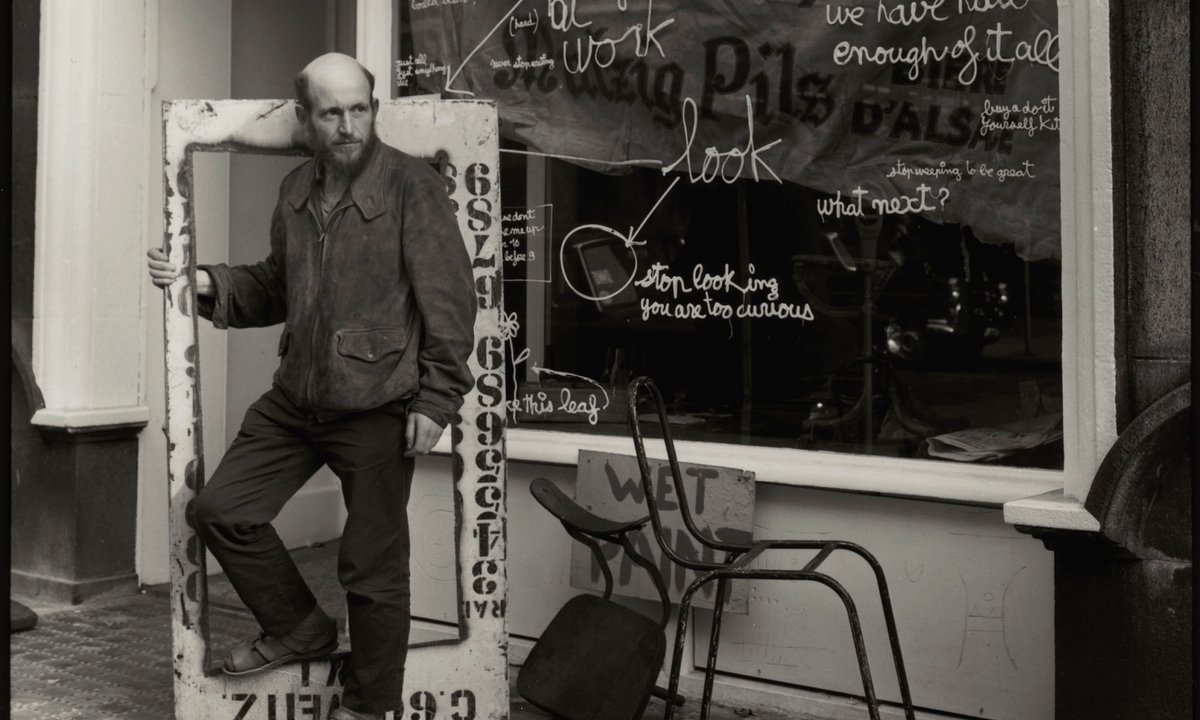Gustav Metzger outside Gallery One during the Festival of Misfits, London, in 1962 ©National Portrait Gallery; Photo: John Cox
The artist Gustav Metzger, who died in 2017 aged 90, was a leading proponent of the auto-destructive art movement. A lifelong activist, Metzger was “one of the truly radical artists of the 20th century”, said Hans Ulrich Obrist, the artistic director of London’s Serpentine Galleries, in tribute. Metzger tells the story of his life and work in a series of interviews with Obrist, outlining how he came to Britain on the Kindertransport (the mass rescue movement of children) in 1939. In 2009, Metzger unveiled Flailing Trees at the Whitworth Art Gallery in Manchester, a sculptural piece comprising 21 willow trees implanted upside down in concrete, which highlighted the threat of global warming. “An artist for our times, Metzger’s uncompromising commitment to combating environmental destruction was fundamental to his understanding of art as a vehicle for change,” says a publisher’s statement.
The Guyanese-British artist Hew Locke unpicks colonialism in a British Museum exhibition (until 9 February 2025) and catalogue, addressing questions around sovereignty, power and nationhood. “I’ve always been interested in the ways objects are interpreted through display in museums. What story has been distilled? How does it relate to the present? How can this telling be questioned, disrupted, or complicated?” Locke says in a statement. He surveys more than 150 objects from the museum’s collection including crowns, archival photographs and drawings, giving his own take on the relics of colonial rule. In the introduction, the British Museum curator Isabel Seligman writes that Locke’s ongoing concern is with “dominant narratives of British history and… bringing hidden histories to the fore as if turning over a rich tapestry to reveal a welter of colourful tangled threads on the other side.”
The catalogue for the exhibition Outlaws: Fashion Renegades of 80s London, on show at London’s Fashion and Textile Museum (until 9 March 2025), centres on the fabled nightclub Taboo, launched in 1985 by the influential late designer and performance artist Leigh Bowery (next year Tate Modern will host the first full-scale UK museum exhibition dedicated to Bowery, a celebrated muse of the artist Lucian Freud). Key figures of the time, such as the artist Peter Doig, the designers Wayne and Gerardine Hemingway, and the photographer Dave Swindells, give insights into the fashion and art explosion of the era. Doig describes his experiences at Central St Martins college, saying: “No one was going to hand you anything on a plate. I think back to the early decades of working on my own throughout that whole time when I was by no means a successful artist and no one had ever seen my work. They knew I was a painter and they used to call me Peter the Painter but I wasn’t a successful painter at all.”
The Hayward Gallery in London presents Leap Year, the first major survey of the Korean-born artist Haegue Yang in the UK. The exhibition and accompanying catalogue chart the artist’s work from 1995 to today, featuring key pieces from notable series, such as her collages titled Mesmerising Mesh (2021-present) made from Hanji, washi, graph and origami paper. The publication also explores Yang’s Venetian blind installations such as Star-Crossed Rendezvous after Yun (2024), a work featuring ascending layers of blinds in varying formations and colours. The catalogue features essays by Yung Ma, the senior curator at the Hayward Gallery, and the writer Pablo Larios along with an artist interview by the curator and writer Lynne Cooke.
The Greek collector Dimitris Daskalopoulos announced last year that he is donating more than 350 works from his vast contemporary art collection to four international museums (Tate, the Museum of Contemporary Art Chicago, the Greek National Museum of Contemporary Art in Athens, and the Solomon R. Guggenheim Museum in New York). With his partner Irini Pari, Daskalopoulos discuss how and why he built up his collection in a series of detailed and candid discussions. Daskalopoulos explains his impetus for collecting: “I always had a central focus of reflection, a question that I used to explore within contemporary art: the human struggle against oblivion and death and the creative power with which human beings face their finite existence.” Pari tells The Art Newspaper: “I think especially in the difficult moments we are living through, artists will express all that we cannot say with words. And I think that is so important.” Daskalopoulos made his fortune in the Greek food industry and is the founder and chairman of Damma Holdings, a financial services and investment company. He established his Athens-based foundation Neon in 2013.

